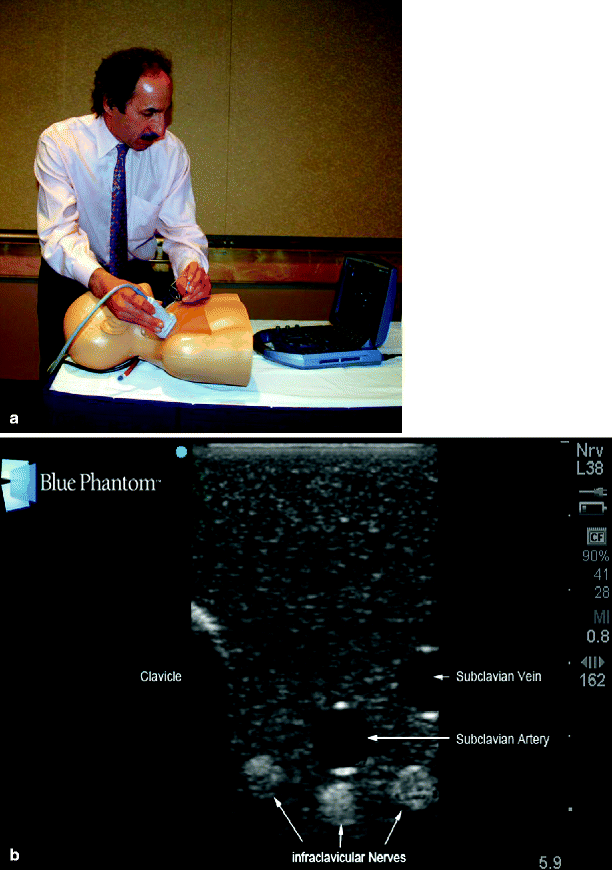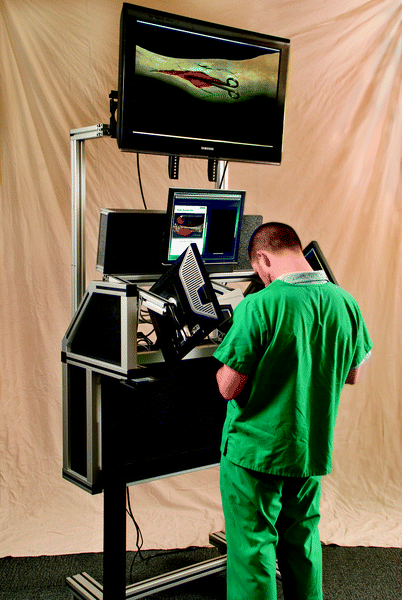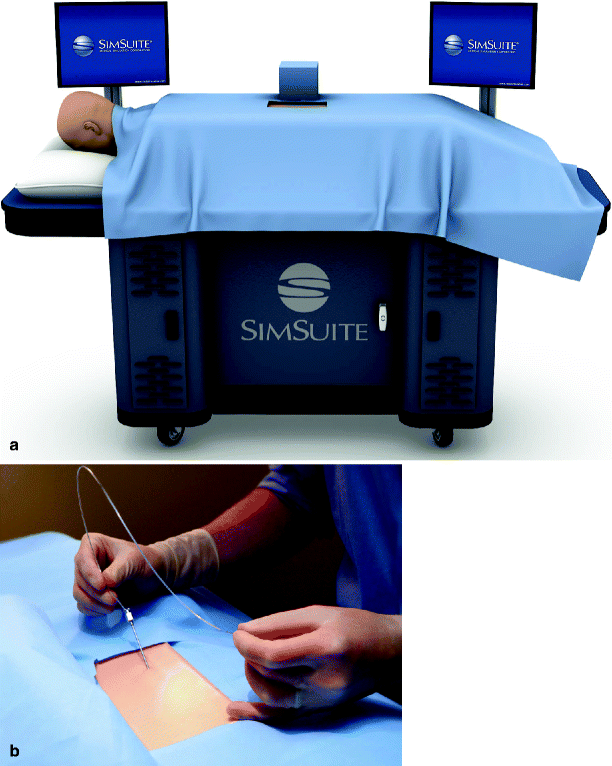Fig. 34.1
Lumbar/thoracic epidural/spinal placement simulator (a) Simulator with back insert in place (b) Teaching epidural placement with the simulator (Reproduced with permission from Blue Phantom™, Redmond, VA)

Fig. 34.2
(a) “Ultrasound Andy,” the original Blue Phantom™ head-neck-upper torso ultrasound-guided regional anesthesia and central venous access model. (b) Ultrasound image of “Ultrasound Andy’s” infraclavicular brachial plexus (Reproduced with permission from Blue Phantom ™, Redmond, VA)
Virtual reality procedural simulators combine haptics (tactile feedback technology) with images of either gross and/or imaging (i.e., ultrasound) derived anatomy. One such device is the Common Platform Medical Skills Trainer (CPMST) from Touch of Life Technologies (Fig. 34.3). Images of gross anatomy derived from the Visible Human Dataset (detailed dataset of cross-sectional photographs of the human body) and of corresponding ultrasound anatomy are coupled with haptic devices, allowing for an immersive, high-fidelity environment for performing ultrasound-guided nerve blocks.


Fig. 34.3
Common Platform Medical Skills Trainer (CPMST) (Courtesy of Touch of Life Technologies, Aurora, CO)
Another VR device is Medical Simulation Corporation’s (MSC) SimSuite® neurostimulation simulator (Fig. 34.4). This technology offers healthcare providers an environment in which to advance their skills in spinal cord stimulation (SCS) from needle insertion to manipulation of leads to mapping for optimal pain management. Simulation features include virtual fluoroscopy for 3D tracking of needle, C-arm manipulation with lateral views, tactile feedback, needle and lead navigation and manipulation, programmable complications, suture skill practice, mapping to optimize pain management for a variety of patient presentations, and patient interaction.


Fig 34.4
(a) SimSuite® Neurostimulation Simulator. (b) Practitioner advancing a spinal cord stimulator lead. SimSuite® Neurostimulation Simulator (Courtesy of Medical Simulation Corporation, Denver, CO)
In addition to allowing practitioners to hone their procedural skills in a risk-free environment, these simulators are portable, allowing for on-site education. Unfortunately, there are no studies detailing outcomes of provider training with either of these simulation platforms.
Future Directions
Most pain medicine procedures are minimally invasive image guided in nature—a combination that readily lends itself to procedural simulation. For example, the CPMST or SimSuite could be expanded to allow for ultrasound, fluoroscopically, or CT-guided procedures such as celiac plexus block, stellate ganglion block, vertebral augmentation, spinals/epidurals, cervical medial branch blocks, and multiple other minimally invasive pain medicine procedures. Synthetic anatomically driven part-task trainers, like those used for peripheral ultrasound-guided blocks, can also be adapted for pain specific procedural simulation.
Rare and Critical Occurrence Management
High-fidelity mannequin simulation of rare and critical events has been well described in multiple medical disciplines; however, little work has been done in the fields of Palliative Care and Pain Medicine [31, 34–38]. An implementation of a simulation program for palliative care providers at the Montagu Clinical Simulation Center in the UK has been described [39]. Scenarios, which were jointly written by staff from several hospitals included anaphylaxis, collapse of a relative, hypercalcemia, spinal cord compression, hemorrhage, an end-of-life event, finding an overdosed patient, and a relative wishing to reverse a “do not resuscitate” directive immediately post cardiac arrest. Elements of crisis avoidance and resource management were integrated into the debriefing process. Participants in this 1-day program reported increased confidence in the management of rare events, greater awareness of the need to plan for such events, consolidation of existing knowledge, appreciation for being able to communicate with colleagues away from situational pressures, and a high sense of personal achievement associated with completing a psychologically demanding educational event. This program provides a good framework for the creation of other Palliative Care simulation curricula.
Application of full-scale mannequin simulation specifically to pain medicine has not been described, although a report has linked a case of successful resuscitation of bupivacaine-induced cardiac arrest to recent simulation training [40]. As previously discussed, the authors are currently creating a MOCA-SUBS Pain Medicine Simulation Curriculum. In addition to the mannequins, the multimodality simulations will include SPs and VR and address topics like anaphylaxis (to IV contrast or local anesthetics), seizure (e.g., IV injection of local anesthetic complicating stellate ganglion block or IV phenol complicating celiac plexus block), respiratory arrest (inadvertent while refilling an intrathecal pump), torsades de points (secondary to methadone toxicity), serotonin syndrome (drug-drug interaction between opioids and tricyclic antidepressants), hypertensive emergencies (during cervical epidural steroid injection), pneumothorax (after paravertebral or intercostal nerve block) and hypotension (due to sympathectomy post celiac plexus block), among others. These simulations will be multimodal, incorporating rare and critical occurrence management simulation, SPs/VR, and procedure simulation in order to enhance their fidelity [22].
Proposed Multimodal Curriculum
The following example, comprised of four stages, is a comprehensive simulation of the management of a 62-year-old male with intractable pain secondary to pancreatic adenocarcinoma presenting for celiac plexus block (Table 34.1).
Table 34.1
Four stages of a proposed multimodal simulation in pain medicine
1. Patient interview and consent |
2. Performance of celiac plexus block |
3. Management of post-procedure complication |
4. Discussion with family/patient |
In the initial stage, the practitioner will interact with a simulated patient (either SP or VR) to perform an assessment and decide if a celiac plexus block is an appropriate intervention. If so, a thorough explanation of the procedure must be provided and consent obtained.
During the second stage of the simulation the practitioner will move to a part-task device where s/he will perform a simulated CT or fluoroscopically guided celiac plexus block. Upon completion of the block the practitioner would have to diagnose that the patient is experiencing local anesthetic toxicity (LAST).
For the third stage of the simulation, a full-scale mannequin simulator will be used to replicate the complication, and the practitioner will proceed to initiate management and activate a help system.
In the final stage of the simulation, the practitioner would return to a standardized patient/s (SP or VR) in order to brief the patient’s family on the procedure, complication, and a proposed pain management plan.
Conclusion
By combining multiple simulator technologies into a suite of simulations, educators can present a comprehensive, engaging experience to introduce and reinforce key concepts and procedural tasks salient to pain and palliative care practitioners. Alternatively, the simulator suite approach allows facilitators to design a thorough assessment of the breadth of a practitioner’s skill set for evaluative purposes. While some of the technologies described in this chapter are still under development, pain and palliative care practitioners involved in simulation can use this generalized multimodal approach with available equipment to create valuable education and evaluation tools.
References
1.
Shawler C. Palliative and end-of-life care: using a standardized patient family for gerontological nurse practitioner students. Nurs Educ Perspect. 2011;32(3):168–72.PubMedCrossRef
Stay updated, free articles. Join our Telegram channel

Full access? Get Clinical Tree








